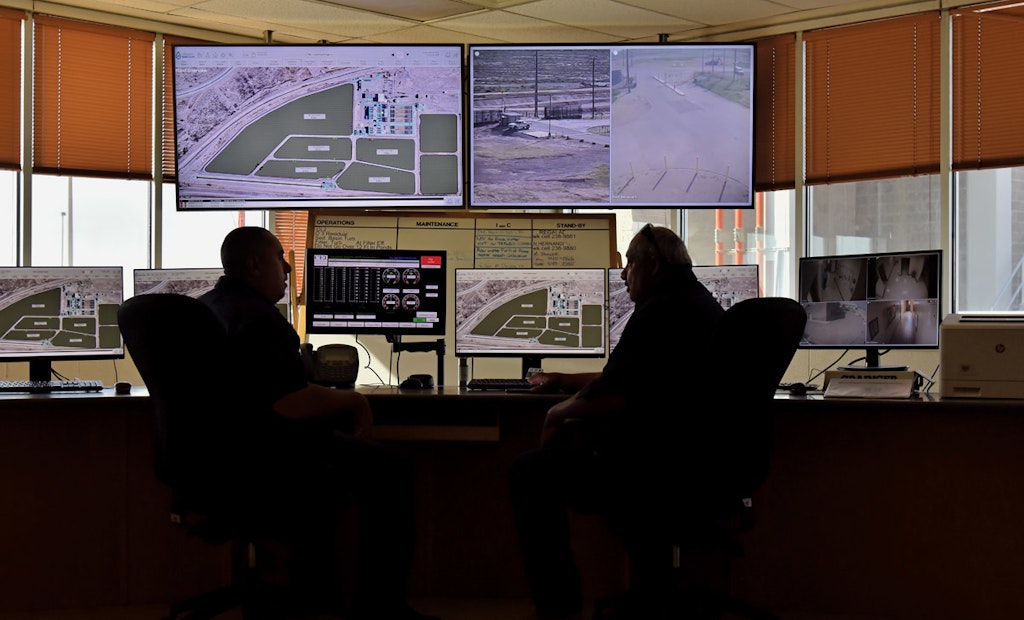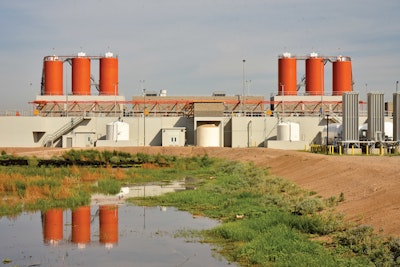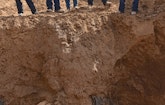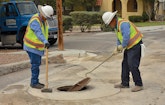
Senior Technician Vincent Ruiz (left) and Assistant Superintendent Ricardo Ruiz in the control room at the Jonathan Rogers Water Treatment Plant in El Paso, Texas. (Photography by Brian Kanof)
Interested in Infrastructure?
Get Infrastructure articles, news and videos right in your inbox! Sign up now.
Infrastructure + Get AlertsMany cities enjoy easy access to abundant drinking water from rivers, lakes, underground aquifers and the like.
El Paso, Texas, is not one of them.
But over the years, El Paso Water — the city’s water and sewer utility — has successfully developed strategies for managing dwindling water sources, figuratively making lemonade out of the lemons tossed its way by Mother Nature and local geology in the form of drought and brackish groundwater.
These efforts have earned the utility a national and global reputation for innovative water management as well as a 2020 award from the Association of Metropolitan Water Agencies for sustainable water utility management.
Along with treated water from the Rio Grande, the utility relies on desalinated water from a massive yet diminishing aquifer, the Hueco Bolson. To boost the aquifer’s sustainability, it also operates a recharge program, slated for expansion later this year, says Scott Reinert, the utility’s manager of water resources.
In addition, the utility plans to build a $100 million, cutting-edge water purification plant, called the Advanced Water Purification Facility. It will turn wastewater effluent into potable water. Furthermore, the utility also is laying groundwork to import groundwater from a source 90 miles east of El Paso.
“We’re trying to educate people that the future of supplying water for El Paso doesn’t mean pumping more from aquifers,” Reinert says. “The future is water portfolio diversification.
“When we needed more water in the 1960s, ’70s and ’80s, our operating model was to pump more from the Hueco Bolson aquifer. But we now need to preserve it for the future, which means building other water sources.”
Unreliable water source
With a population of around 679,000 people, El Paso stands at the far western tip of Texas and along the northern banks of the roughly 1,900-mile-long Rio Grande. Fed primarily by snowpack melt in southern Colorado and northern New Mexico, the river — which forms a roughly 1,200-mile boundary between the United States and Mexico from El Paso to the Gulf of Mexico — supplies drinking and irrigation water to more than 6 million people and millions of acres of land in the United States.
The utility’s annual allocation of river water is dictated by the Rio Grande Compact. Signed in 1938, the agreement spells out equitable water distribution between Texas, Colorado, New Mexico and Mexico.
But due to longstanding drought conditions, the utility hasn’t received its full allocation of water in more than a decade. Under a full allocation, El Paso — which averages only 9 inches of rainfall per year — used to obtain a large portion of its drinking water from the river from March through October, Reinert explains.
“This year it’ll be only from June through the end of August,” he says.
When river water isn’t available, the utility relies on other sources, including 120 wells — some up to 1,000 feet deep — that tap into the Bolson aquifer and another one nearby, the Mesilla Bolson, which doesn’t require desalination.
The utility serves about 218,670 customers in about a 260-square-mile area. It operates and maintains roughly 2,767 miles of water mains (and 2,368 miles of wastewater sewers), three water treatment plants with a total capacity of up to 130 million gallons per day and a desalination plant that produces up to 27.5 mgd.
Purifying brackish water
Faced with dwindling water from the Rio Grande, the utility in 2007 tapped into a previously unusable source: brackish groundwater from the Hueco Bolson aquifer.
“Brackish groundwater is a challenge in the West, where many aquifers include areas of salty water,” Reinert says. “The eastern half of El Paso is more prone to brackish water and the western half of the city has fresh water, even though it all comes from the same aquifer.”
A pivotal component in this strategy was the construction of the $93 million Kay Bailey Hutchison Desalination Plant. (It’s named after a well-known Texas politician who served as a U.S. senator from 1993 to 2013 and helped obtain funding for the project.)
The plant, which opened in 2007, is located on the city’s east side near El Paso International Airport. It was funded by a $25 million grant from the U.S. Environmental Protection Agency, cash reserves and bond issues.
“It’s the largest inland desalination plant in the world and we’ve welcomed many guests who’ve come from around the globe for tours,” says Denise Parra, the utility’s public affairs officer. “We just hosted a delegation from Egypt in June.”
A total of 32 wells near the plant feed brackish water into the plant, where a reverse osmosis process removes salt. Another 10 wells on the city’s east side also pump brackish water, but it’s treated at the wellheads, not at the plant.
Deep-well injections
Desalination produces a waste product in the form of highly concentrated brine. At seaside plants, this concentrate typically is returned to the ocean. This obviously isn’t an option in West Texas, but regional geology provides the utility with a solution: deep-well injection.
After extensive testing and approval by state regulatory authorities, El Paso Water was granted permission to dispose of the concentrate in three 4,000-foot-deep injection wells, which are actually natural fractures in underground limestone-dolomite formations that already house salty water, Reinert says.
The wells are about 20 miles east of the plant, outside the city limits. Typically, about 1 million gallons of concentrate a day are fed to the wells via a pipeline.
“The wells are salty reservoirs with sufficient storage and a clay layer around them that contains the injected concentrate,” Reinert says. “We’re a unicorn in this respect — it’s very unique to find this environment away from the city and at a sufficient depth for disposal.”
Concentrate from the 10 small wellhead desalination units is treated at one of the utility’s four wastewater treatment plants.
Sustaining the aquifer
Pumping water from the roughly 500-square-mile Hueco Bolson aquifer, which sprawls under northern New Mexico, West Texas to Mexico, helped reduce the city’s reliance on diminishing Rio Grande water. But it also eventually contributed to lower aquifer water levels.
“The Hueco Bolson aquifer has been pumped for more than 100 years,” Reinert notes. “It’s been a huge component of our water supply.” (The utility annually pumps about 40,000 to 50,000 acre-feet of water from the aquifer.)
“But in the 1960s, ’70s and ’80s, we began to notice that the water level was dropping because of over-pumping,” he continues. “So we developed a recharge program.”
The program went online in 1985. Since that time, the utility has recharged the Hueco Bolson with more than 80,000 acre-feet of water, Reinert says. Initially the utility used 10 injection wells to recharge the aquifer but they frequently clogged, forcing the utility to examine less expensive alternatives.
“The only people that liked the injection wells were our well contractors,” Reinert quips.
Again, local geology provided an alternate technique: infiltration basins.
“We found we had the appropriate geology for a recharging method known as infiltration,” he notes. “We’ve had a couple good situations here for both disposing of concentrate and recharging the aquifer, that’s for sure.”
Infiltration basins
Building an infiltration basin requires excavating a 5- to 10-foot-deep layer of caliche (pronounced “kah-lee-chee”), a cement-like sedimentary rock common in the Southwest. Water is pumped via pipeline to the basin, where it rapidly infiltrates the soil and travels to the water table some 400 feet below.
“Our six basins on the northeast side of El Paso are very low cost on the capital side and low cost on operation side,” Reinert points out. “A well costs about $500,000 and excavating a basin costs about $100,000. They’re a very elegant and inexpensive solution.”
So where does the water for recharging come from? The Fred Hervey Water Reclamation Plant, which produces about 12 mgd of drinking-quality water.
“The Hervey plant was among the first in the nation to create drinking-quality water by treating used water and demonstrated the feasibility of artificial aquifer recharge,” Reinert says.
State regulators require the plant to produce effluent that meets drinking-water quality requirements because it’s located 20 miles away from any kind of river or natural waterway that would normally receive effluent discharge.
The plant produces about 7,000 acre-feet of high-quality water annually. Around 3,000 acre-feet goes toward recharging the aquifer and the rest is used for golf course irrigation or is purchased by a local electrical utility, El Paso Electric, for use at its cooling plant.
Enhanced efforts
Looking ahead, the utility plans to expand its aquifer recharging efforts, enlarge its water portfolio and boost water conservation measures, Reinert says.
The utility plans to evolve its aquifer recharging methods by building what’s called an enhanced arroyo (a Spanish term for a steep gulch), starting this fall. The 2-mile-long, $12 million first phase of the project, largely paid for by funds from the U.S. Bureau of Reclamation and a state agency, will work much like an infiltration basin.
“It just enhances a natural arroyo by excavating anything that blocks water movement,” he says. “It’ll be located in the same area as the other basins.
“Ultimately, we plan to build a pipeline from the Hervey plant to the arroyo a few miles away that will allow us to use additional water for recharge. The other basins haven’t reached capacity — we’re just looking for augmenting our current recharge program and thinking about long-term aquifer sustainability.”
The utility also plans to build a 6-mile pipeline from a water booster station to the enhanced arroyo to further increase aquifer recharge efforts.
Multiple water sources
In the long run, many factors remain unknown as the utility prepares for the future — particularly the state of Rio Grande water allocations. Even at its depleted levels, the river currently still supplies about 40% of the city’s annual water supply.
But one thing is certain: The utility remains tightly focused on its primary mission — to provide customers with a sustainable water supply. And a diverse water portfolio is critical to the goal.
“Everyone is familiar with cities that have river water available 24/7, 365 days a year,” he says. “But we rely only partially on a river, plus freshwater wells, desalination, two aquifers, a water purification plant and, in the future, imported water.
“We have five or six tools hanging from our tool belt,” he continues. “That’s the definition of diversity.
“We’re building a sustainable water future for El Paso and our motivation is diversification rather than desperation. What we’re doing right now will determine whether El Paso can thrive in 20, 30 or 50 years.”












